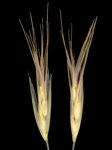
T. sp. Mt Ella spikelets.
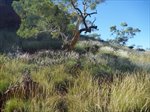
T. sp. Mt Ella habitat.
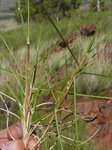
T. sp. Mt Ella leaves covered in resin.

T. sp. Mt Ella leaf section.
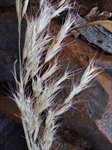
T. sp. Mt Ella inflorescence.
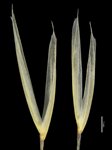
T. sp. Mt Ella glumes.

T. sp. Mt Ella lemmas.
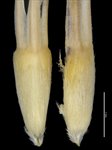
T. sp. Mt Ella lemma bases.

T. sp. Mt Ella paleas.

T. sp. Mt Ella map.
Name
Triodia sp. Mt Ella (M.E. Trudgen 12739)
Derivation
In Western Australia a phrase name is sometimes coined to refer to an un-named taxon, using a geographical reference name (Mt Ella), and a unique specimen collection number (M.E. Trudgen 12739), in order that the name can later be unambiguously placed once its taxonomy is resolved.
Common name
Gully Spinifex
Synonyms
None
Diagnostic features
Foliage copiously resinous; leaf sheath surfaces glabrous (but margins sometimes hairy); leaf blades epistomatous (soft-type); lower glume narrowly lanceolate, 6.3–10.5(–12) mm long, 3–5-nerved; lemmas awned, bitextured with a sharp transverse demarcation line, with uniformly-distributed appressed hairs on the lower part; callus <0.6 mm long, blunt to acute; palea bitextured, hairy; in gullies on sides of hills in the eastern Hamersley Range, adjacent margins of the Gascoyne region and east to Rudall River area.
Habitat
Occurs in rocky gullies, gorges and below cliffs on the side of hills and mountains.
Distribution and frequency
Occurs in the eastern Hamersley sub-region, and immediately adjacent parts of the Fortescue sub-region and Gascoyne region, with an isolated occurrence to the east near Rudall River.
Similar species
Triodia sp. Mt Ella is a member of the Soft group, sharing the epistomatous (soft-type) leaf blades, and resinous foliage. The narrowly lanceolate glumes, lemma awns and bitextured lemma are shared with several other species: T. avenoides, T. basitricha, T. degreyensis, and T. schinzii.
Triodia avenoides, T. degreyensis, and T. schinzii have longer glumes 12.4– 32 mm long with more nerves (7–13) than T. sp. Mt Ella that has glumes 6.3–10.5(–12) mm long and 3–5 nerves. Triodia avenoides and T. schinzii also have glabrous paleas and a callus 0.8–1.5 mm long (palea hairy, callus <0.6 mm long in T. sp. Mt Ella) and occur on sandy or sandy loam flats and dunes (rocky slopes in T. sp. Mt Ella).
Triodia basitricha can be distinguished by having hairy leaf sheath surfaces and non-resinous to weakly resinous foliage (leaf sheath surfaces lacking hairs, but margins sometimes hairy, and foliage copiously resinous in T. sp. Mt Ella).
Conservation status
Priority Three.
Identification without florets
Triodia sp. Mt Ella can be distinguished by a combination of resinous foliage, narrowly lanceolate glumes, habitat and distribution. Only two other species (T. melvillei and T. schinzii) in the same area have resinous foliage and narrowly lanceolate glumes.
Triodia sp. Mt Ella occurs on rocky slopes and gullies (T. melvillei is usually on flats in the Pilbara), has longest basal pedicels 5–15.5 mm long (1.6–6.5 mm long in T. melvillei) and usually fewer florets (28–84) in the inflorescence (compared to 57–286 in T. melvillei). Triodia schinzii always occurs on red sand and has longer glumes >12.5 mm long, compared to 6.3–10.5(–12) mm long in T. sp. Mt Ella.
Variation
A fairly uniform species. Leaf sheath margins can be glabrous or hairy.
Notes
Lazarides (1997), Lazarides et al. (2005) and Ausgrass (Sharp & Simon, 2002; Simon & Alonso, 2014) treated T. sp. Mt Ella under T. bitextura.
A full description of T. sp. Mt Ella can be found in Barrett & Trudgen (2017).